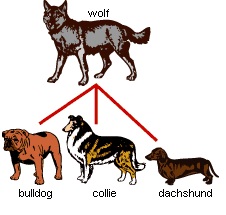READ: Artificial Selection
Artificial Selection: Dogs
The domestication of dogs is an example of selective breeding in animals. All domesticated dogs are the same species (Canis familiaris) but exhibit incredible variation from the tiny Chihuahua to the enormous St. Bernard, from the hairless Chinese Crested Terrier to the long haired English Sheepdog, and from the intelligent Border Collies to the challenged Irish Setters. Recent mitochondrial DNA analysis suggests that wolves split into two lines about 100,000 years ago. One line was the wolf ancestors which led to modern dogs. Domestication of these “wolf” dogs occurred about 15,000 years ago. The relationship of humans with dogs was probably accidental. About this time, it is believed that humans were giving up their nomadic lifestyles and staying at semi-permanent campsites. Wolf-dogs probably started hanging around these campsites scavenging food. Over time, social dogs integrated into human society. Humans then started selecting for more sociable dogs and dogs eventually became “man’s best friend.” Currently, there are up to 800 breeds of dogs recognized by various kennel clubs. All of these breeds originated from the same wolf-dog ancestor. Humans have routinely chosen the parent dogs for breeding because of the traits that they possessed. It was well known that the puppies had a good chance to be born with the desired trait. The puppies that did not possess the desired traits were not bred in the next generation. These breeding techniques were being practiced before the concept of the gene was understood.
Gregor Mendel and others have since explained how the existence of different forms of a gene can produce puppies with unexpected trait combinations. An example of selective breeding in dogs is one of the smallest breeds, Daschunds. In this case, the traits that were selected for were small size and short legs. After many generations, a dog breed capable of following small prey like foxes, badgers, and rabbits into burrows and flushing them out into the open for hunters was produced. The Great Dane is another result of selective breeding. These dogs were created by selecting for their large, heavy size. They were used for hunting, protection, and fighting. Dog breeds were created by selecting traits that would help humans hunt, work herds, protect property, be status symbols, to race, and to be companions.
